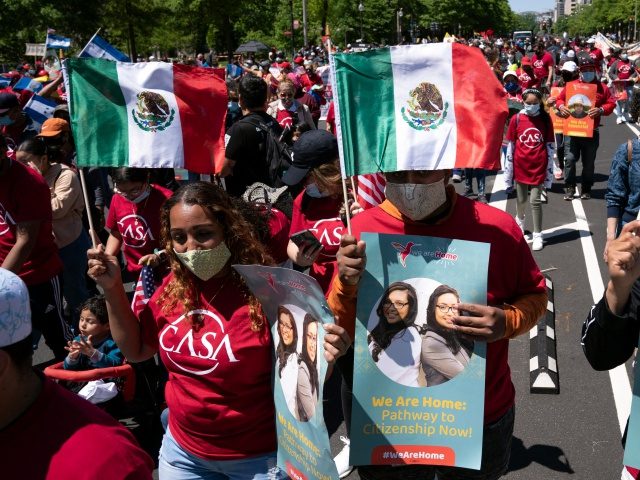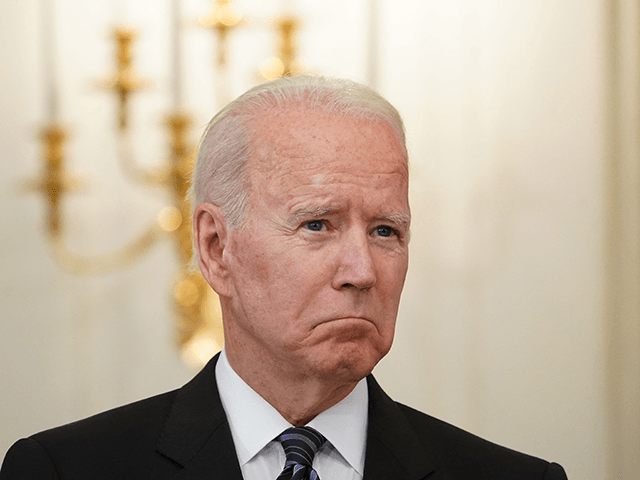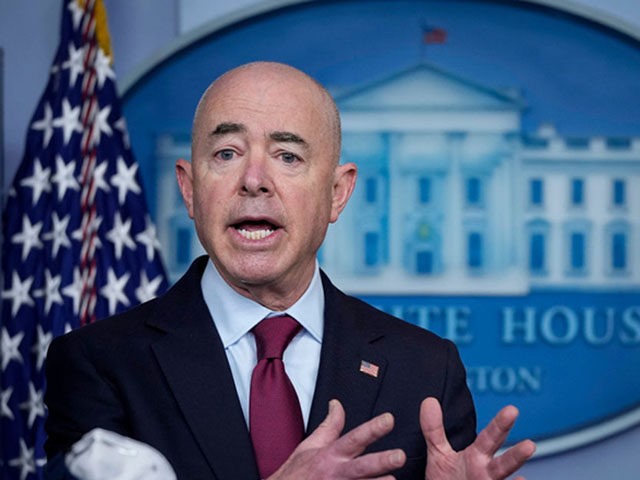Democrat Congressman: No Spending Package Without Amnesty for Millions of Illegal Aliens

Rep. Jesús García (D-IL) says he will not support a reconciliation spending package, which only would need majority support in the Senate, that does not include amnesty for illegal aliens.
In exclusive statements to The Hill, García said “a robust and equitable budget reconciliation deal must include” amnesty for millions of illegal aliens, specifically those enrolled and eligible for the Deferred Action for Childhood Arrivals (DACA) program, beneficiaries of Temporary Protected Status (TPS), and so-called “essential workers.”
García told The Hill:
We must seize this historic opportunity to bring compassion and dignity to our immigration system and provide the certainty that comes with having the legal status that millions of immigrants and their families deserve. [Emphasis added]
…
This is crucial for thousands of undocumented essential workers I represent. They sacrificed themselves to keep this country running during the worst of the pandemic and frequently had no access to relief or medical assistance for fear of being deported. We owe it to them. [Emphasis added]
As Breitbart News has reported, House and Senate Democrats are looking to slip an expansive amnesty for illegal aliens through the little-known reconciliation process where federal spending can receive approval with only a majority of support in the Senate and no threat of a filibuster to hold up a vote.
One such package by Sen. Bernie Sanders (I-VT) is expected to include provisions that would force American taxpayers to spend $150 billion on providing amnesty to millions of illegal aliens.
Likewise, members of the House Progressive Caucus have nearly threatened to tank any package that does not include amnesty for millions of illegal aliens.
Rep. Pramila Jayapal (D-WA), head of the caucus, said amnesty is one of her “needs” in a reconciliation package:
The amnesty proposals come as corporate interests have boosted their push to inflate the United States labor market by legalizing for American jobs the majority of the nation’s 11 to 22 million illegal aliens.
Center for American Progress, a left-wing lobbying group funded by big corporations, is insisting to lawmakers that amnesty for illegal aliens “can and should be done through the budget reconciliation process.”
In May, Facebook CEO Mark Zuckerberg’s FWD.us hired a former assistant Senate parliamentarian to craft a plan for Democrats that would pass amnesty for illegal aliens through reconciliation.
Democrats, along with some House Republicans, have the support of a large amnesty coalition which includes former President George W. Bush, the U.S. Chamber of Commerce, the Business Roundtable, and a number of Koch brothers-backed organizations.
Already, current immigration levels put downward pressure on U.S. wages while redistributing about $500 billion in wealth away from America’s working and middle class and towards employers and new arrivals, research by the National Academies of Sciences, Engineering and Medicine has found.
The Congressional Budget Office (CBO) has repeatedly found that amnesty for illegal aliens would be a net fiscal drain for American taxpayers while driving down U.S. wages.
Every year, 1.2 million legal immigrants receive green cards to permanently resettle in the U.S. In addition, 1.4 million foreign nationals are given visas to take American jobs while hundreds of thousands of illegal aliens enter the U.S. annually.
John Binder is a reporter for Breitbart News. Email him at jbinder@breitbart.com. Follow him on Twitter here.
Jobless Claims Unexpectedly Climb Higher to 373,000

New claims for unemployment benefits rose last week, the Department of Labor said Thursday.
Initial jobless claims climbed to 373,000 for the week ended July 3. Economists polled by Econoday had estimated 353,000 new claims after last week’s initial estimate of 364,000.
The prior week’s claims were revised up to 371,000.
Many Americans are hanging back from working because, for a very large share of those unemployed, supplemental federal jobless benefits, on top of regular state unemployment aid, pay them more than their old jobs did. Others are contending with health and child care issues related to COVID-19 and, in some cases, with career uncertainty after the recession wiped out many jobs for good. Some who have lost work during the pandemic have decided to retire while others have rethought their career choices after working from home or being out of work during the pandemic.
Many states, though, are set to begin dropping the supplemental federal jobless aid this month. That is likely prompting many Americans to return to work. The enhanced benefits, which pay $300 a week on top of an average $320 in state benefits, are set to expire nationwide in September.
With mask orders and capacity limits being lifted, vaccinations up, and more consumers venturing out to spend — on restaurant meals, airline fares, movie tickets, and store purchases — the economy is rapidly recovering from the recession. All that renewed spending—helped along by stimulus payments that went out in March and April—has fueled customer demand and led many companies to seek new workers, often at higher wages, and avoid layoffs. Consumers are shifting some of their spending from household goods to long-neglected services and vacations.
The speed of the rebound from the recession has caught many businesses off guard and touched off a scramble to hire. In June, the economy added 850,000 jobs, including 343,000 in leisure and hospitality. In May, employers added a less-than-expected 583,000 jobs but job openings hit a record high of 9.2 million. And the gap between hiring and openings expanded, evidence that many companies are struggling to find enough workers as the economy recovers faster than expected. In April, companies posted over 9 million job openings, a record high and a jump of 12 percent from March but just 269,000 workers were added to payrolls.
Fiscal stimulus and loose monetary policy, however, are fueling inflation. As well, the sudden lurches in the economy have caused bottlenecks in the supply chain, triggering shortages and skyrocketing prices for things like used cars, lumber, and grains. Those rising prices are taking their toll and squeezing households. Retail spending actually fell in May, homebuilding is stalling, gasoline is at multi-year highs, and inflation-adjusted incomes have been declining as wage gains get swamped by larger rises in the cost of living.
“It turns out it’s a heck of a lot easier to create demand than it is to, you know, to bring supply back up to snuff,” Fed chair Jerome Powell said in a press conference at the conclusion of the Federal Open Market Committee’s June meeting.
Despite the higher than expected inflation, Powell said the Fed intends to keep rates low for as far as the eye can see. The Biden administration continues to push for billions of dollars of more spending, which many economists think will add to the inflationary pressures without substantially improving the performance of the economy. The economic projections of Fed officials showed that they expect inflation for the full year to run a full percentage point higher than they did in March while expectations for economic growth improved by just half a point and unemployment expectations did not improve at all.
DHS Chief Mayorkas in Guatemala: U.S. May Create ‘Other Legal Paths’ for Migrants

President Joe Biden’s border chief told government leaders in Guatemala that he is seeking to create “other legal paths” for migrants to enter the United States, according to a Spanish-language news agency.
Alejandro Mayorkas, the secretary of the Department of Homeland Security (DHS), met with Guatemalan President Alejandro Giammattei on Tuesday.
Spanish news wire EFE quoted the DHS secretary as saying he discussed creating “other legal paths so that people do not need to migrate irregularly, putting the lives of children or their trust in people who do not have permits at risk.”
“The fact that people leave [Guatemala] for different reasons is driving them to put their lives at the discretion of traffickers, in whose hands we cannot guarantee their safety. We have started and developed programs so that the population does not have to travel in an insecure way,” Mayorkas added.
Mayorkas, who arrived in Guatemala for a two-day visit Tuesday, noted the U.S. already provides Guatemalans H-2B visas for temporary jobs and H-2A visas for agricultural work.
The DHS chief also signed two agreements to combat organized crime and tackle illegal migration at the Central American country’s borders and ports during the meeting.
Guatemalan Foreign Minister (FM) Pedro Brolo, who also attended the meeting, reiterated Guatemala’s Temporary Protected Status (TPS) request for its compatriots riding illegally in the United States. Each year, an estimated 300,000 Guatemalans attempt to sneak across the U.S.-Mexico border, a figure that appears to include those who successfully make it through.
Citing official U.S. figures, EFE noted there more than three million Guatemalans in the United States, the majority of them illegal aliens, adding that each year at least 300,000 individuals attempt to sneak across the U.S.-Mexico border, an estimate that appears to include those who successfully make it through.
According to data from the U.S. Customs and Border Protection (CBP) agency, a component of DHS, border agents have encountered over 600,000 Guatemalans along the border since 2018, a figure that excludes those who avoid detection.
Via Twitter, the DHS secretary noted that he joined the Guatemalan president and FM to discuss various issues of shared interest, including “respecting the dignity of every human being.”
Guatemala borders Honduras and El Salvador in the south and Mexico in the north. The DHS chief said at the meeting that the U.S. would strengthen security at Guatemala’s borders.
Meanwhile, critics accuse the Biden administration of implementing a semi-open border policy responsible for a huge surge of migrants that has overwhelmed U.S. personnel and resources.
The agreements with Guatemala are essential to the Biden-Harris administration’s vision of strengthening local development and undermining corruption, drug trafficking, and human smuggling, Mayorkas told reporters after meeting Giammattei, according to EFE.
Mayorkas declared that the Biden-Harris administration “is committed to strengthening [the security of] the ports of Guatemala, fighting corruption, strengthening port operations and stopping the illicit drug trafficking and other articles.”
Under the agreements, the U.S. commits to fight customs fraud and illegal migration through the Guatemalan ports of entry.
Moreover, the U.S. will help train 1,500 new police officers to protect the Central American country’s border against human trafficking.
Mayorkas stressed that “the battle against illicit trafficking is important for the prosperity [of Guatemala] and to strengthen trade and legal travel between countries.”
The DHS secretary also confirmed that the U.S. would donate 1.5 million doses of Moderna vaccines against the Chinese coronavirus, scheduled to arrive in Guatemala next Thursday.
He wrote on Twitter, “The United States is supplying these life-saving vaccines to Guatemala for a simple reason: this is a global pandemic, and we can only end it if we get shots into everyone’s arms, safely, swiftly, equitably, no matter where they live.”
Mayorkas’s visit comes a month after Vice President Kamala Harris visited Guatemala and Mexico in early June.
President Joe Biden tapped Harris to address the alleged “roots” of migration in the Northern Triangle countries of Guatemala, Honduras, and El Salvador in Central America.
The White House, Democrats, establishment media allies, immigration advocates, and Republicans blasted Harris’s visit as a failure.
Biden has now sent Mayorkas to the region twice after Harris, including right after her trip and the ongoing visit to Guatemala. Harris’s team has reportedly indicated that the VP wants to avoid the border crisis because it can hurt her chances of becoming president in the future.
The Biden administration saw the Northern Triangle as key to dealing with border crisis fueled by the record-shattering surge of migrants, who traditionally came from that region.
Echoing a recent Breitbart News analysis, however, the Washington Post reported Tuesday that migration from the Northern Triangle is dropping and is offset by migrants from outside the region, including Mexico and a growing number of nations beyond that country and Central America.
Panamanian authorities, who help U.S.-bound illegal migrants aided by the State Department transit through their country, have warned of an unprecedented wave of migrants from Haiti, Cuba, and as far as Asia, Africa, and the Middle East.
Breitbart News has noted that Biden’s lenient immigration policies are attracting migrants from across the globe.
No comments:
Post a Comment